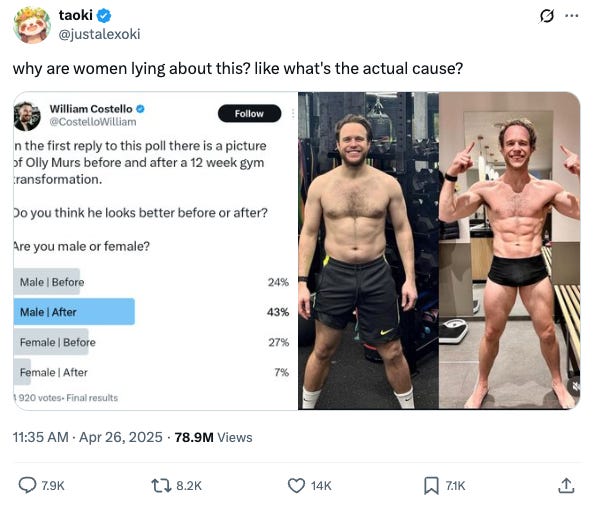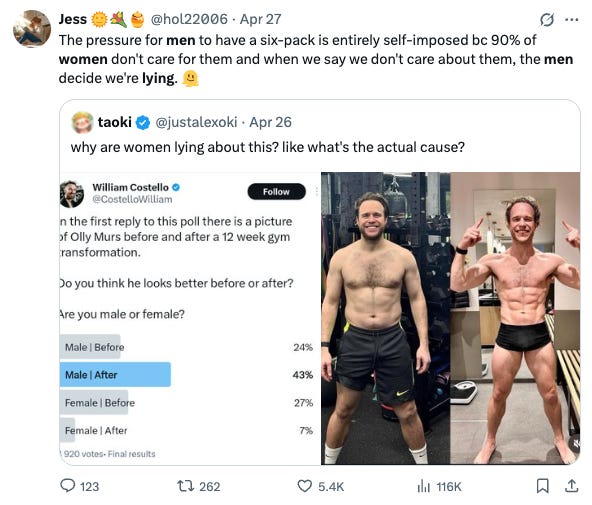the dad bod strikes again
British pop-star Olly Murs before and after photos divide the internet
If you spent even ten minutes on 𝕏 last weekend, you saw the Olly Murs transformation shot—soft-core Olly on the left, twelve-week ab-bot on the right. By Monday morning, my feed was totally saturated. Paired with various polls from around the internet, a full-blown culture war had broken out over the British pop-star’s 12-week transformation.
Evolutionary-psych researcher William Costello ran an early poll that collected nearly five thousand votes and really kickstarted all this madness. The split was brutal: 63% of men liked the abs, only 20% of women did; meanwhile a whopping 80% of women chose the fluffier “before.”
But it wasn’t just William’s poll—in every poll I came across, women overwhelmingly said they preferred the before photo.
The comment sections turned feral. Quote tweets by men swearing women were lying, and by women swearing they were not, ensured—with @justalexoki’s thread blowing past seventy-eight million views (lol).
here’s why women aren’t lying—
When women look at a man’s frame, we don’t inventory muscle fibers the way men do. For us, it’s not just about raw muscle or fat percentage. It’s about what the body signals. Subconsciously, we’re scanning for strength, competence, protection, vitality—not “hours logged at the gym.” We’re reading for subtext: Can he protect? Does he look healthy enough to outrun trouble? Will he place the last slice of pizza into his macros app while the house is on fire? Functional strength—broad shoulders, a dense core, competent hands—ticks those boxes more reliably than a paper-thin midsection ever will.
A body that looks strong enough without looking obsessed sends a more reliable survival signal than a body that looks like it could die if its next protein shake is delayed by fifteen minutes.
History backs this preference. For most of human existence a man’s physique was forged by work that mattered: hauling game, stacking stone, swinging an axe. The resulting build looked closer to Olly-before than Olly-after—solid, lived-in, and vaguely prepared for winter.
The guy in the “before” photo still carries that old-world signal. He looks strong enough to pick you up and toss you over his shoulder or build a shelter if he had to, but not so engineered that you wonder if he’s worried about his diet in the middle of a crisis. The “after” photo definitely looks impressive. But it also crosses into something more self-referential. It’s a body that’s become the project itself. And for a lot of women, even if they respect it, it’s just not as compelling.
Men, naturally, see a different scoreboard. More definition equals more value because definition telegraphs discipline, risk tolerance, and—if we’re being honest—competitive status among other men. That last part is crucial. Extreme physiques are often homosocial signals. The guy shredding down to eight percent body fat usually isn’t aiming at the female gaze; he’s speaking in dialect to the lifter three benches over who can translate macros and mesocycles. Men admire the discipline because they understand the code—calories counted, sets logged, willpower flexed.
And don’t get me wrong, women play the same game with makeup. Contour, cut-crease, and lash stacks are fluent to other women and almost invisible to most men who don’t know the difference between bronzer and blush. Makeup, like muscle, is as much about status among insiders as it is about attraction to outsiders.
the sweet spot: effortless strength—
Because attraction runs on a bell curve, the dreaded too much exists. Past a certain point, visible veins don’t say “protector”; they say “I hope you enjoy eating chicken and rice on Christmas.” On the bell curve of female preference, moderate muscularity ranks highest; beyond that, attractiveness flattens out and can even decline. A six-pack may demonstrate discipline, but it also hints at vanity, rigid dieting, and hours lost to mirror selfies.
At the other end, unchecked softness drifts from approachable into complacent. Between those poles lies what the poll exposed—a band of “effortless strength.” Think 12 to 18 percent body fat, shoulders wider than the waist, a body that could build a fence but can also ignore the scale for a weekend.
Call it the “accessibility premium.” Hyper-defined physiques advertise discipline, yes, but also time—again, hours logged in the gym, food scale on the counter, macro spreadsheets. To many women that screams scarcity: if he’s scheduling leg day and chicken-breast weigh-ins, where does intimacy fit?
The lightly trained body, by contrast, signals surplus—of time, attention, emotional availability. He’ll still lug a couch up three flights, yet he looks like someone who sometimes remembers your coffee order and occasionally eats the croissant with you.
That, incidentally, is what the original “dad-bod” meme celebrated. Not surrender, not sloth—just the relaxed competence of a former athlete who traded sprints for school runs. Then the term mutated. Marketers slapped it on every nacho-crusted decline, and suddenly dad-bod covered everything from “retired fullback” to “four-alarm metabolic syndrome.”
Let’s be honest: there’s a massive difference between a man who has aged into his body and a man who has abandoned it.
None of this is new. Evolutionary-psych studies have long suggested women rate moderate muscularity highest—too little looks weak, too much hints at aggression or high maintenance. What’s fresh is watching the algorithm shove those subconscious heuristics into public vote tallies, then letting both sexes marvel at how far apart their mental models really are.
If you’re a man, the takeaway isn’t stop training. It’s train for life, not for Lightroom. Pursue the kind of durability that shows up when the heavy stuff needs moving or the cat needs rescuing from a tree. The body that feels lived-in beats the body that feels curated. Women tend to be drawn towards strength that feels effortless, not performative.
And for anyone still insisting that women are “lying” about preferring the softer photo: trust the vote count. Men can keep chasing personal records—strength is useful, longevity matters—but if the goal is genuine cross-sexual appeal, it’s worth noting that the poll has already spoken. Women weren’t playing coy; they were voting for the physique that leaves energy for life outside the gym mirror. Less obsession, more capability. Less spreadsheet, more presence. That’s the body evolution designed us to trust, and the one social media just measured in real time.
Thanks for reading, hope to see you again soon. xx


















Maybe
https://www.cheirophilus.com/p/on-before-and-after-gym-transformations
Nah, still think you’re just lying.
Last ones especially obviously: “obviously it’s because his personality is bad”, which you get from a photo alone, for imagined, supposedly non shallow reasons?